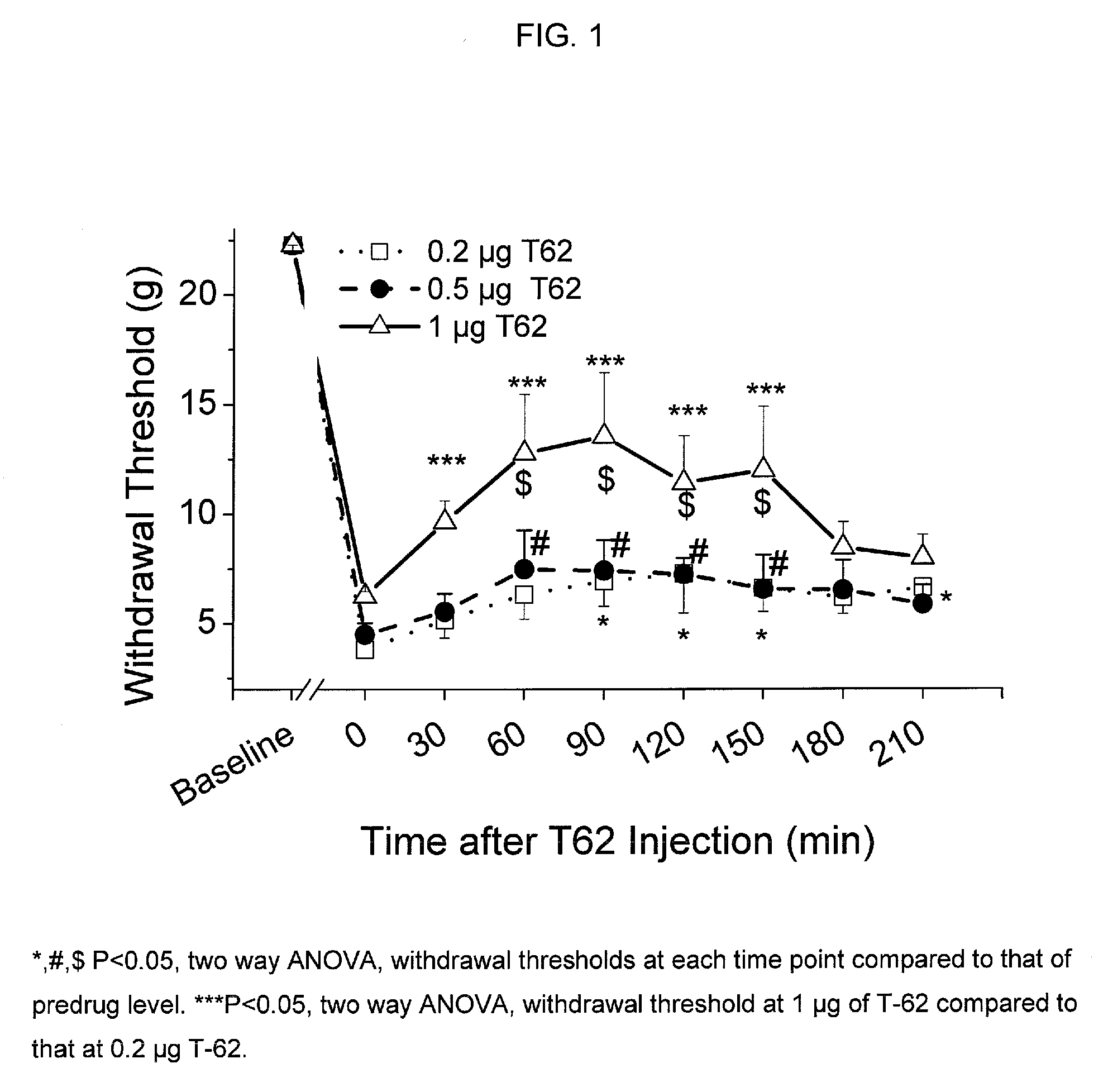Combination therapy for the treatment of pain
a combination therapy and pain technology, applied in the field of synergistic combinations, can solve the problems of limiting the dosing of opioids for postoperative pain, continuing to demonstrate a high incidence of severe pain, and accompanied by bothersome side effects of potential postoperative analgesics such as 2 adrenergic receptor agonists and glutamate receptor antagonists
- Summary
- Abstract
- Description
- Claims
- Application Information
AI Technical Summary
Benefits of technology
Problems solved by technology
Method used
Image
Examples
example 1
Postincisional Hypersensitivity Model
[0082] Animal preparation: Following Animal Care and Use Committee approval, an intrathecal (i.t.) catheter with tip in the lumbar space is inserted as previously described in adult male rats weighing 250 g (Yaksh and Rudy, Physiol Behav. 1976, 7, 1032-1036). One week following the insertion of the i.t. catheter, paw incision surgery is performed as previously described (Brennan et al., Pain 1996, 64, 493-501). Briefly, animals are anesthetized with halothane, and a 1-cm long incision is made in the plantar aspect of the left hind paw starting 0.5 cm from the edge of the heel toward the toe after sterile preparation with 70% ethanol. The plantaris muscle is elevated and incised longitudinally. The wound is closed with 2 mattress sutures of 5.0 silk. Subsequently, withdrawal threshold to von Frey filaments is determined one day after surgery (Chaplan et al., J. Neurosci. Methods, 1994, 53, 55-63). For all testing but pilot dose ranging studies, i...
example 2
Neuropathic Pain Model
[0094] Spinal Nerve Ligation: After Animal Care and Use Committee approval, male Sprague-Dawley rats (Harlan, Indianapolis, Ind., USA) weighing 180-200 g undergo anesthesia as previously described by Kim and Chung (Pain 1992, 50, 355-363). Briefly, under general anesthesia with inhalational halothane, the left L5 and L6 spinal nerves are identified through a small laminotomy and tightly ligated. Approximately one week later, an intrathecal catheter is placed under general anesthesia by insertion under direct vision of a polyethylene catheter through a small slit in the dura at the cisterna magnum, and advanced 8.5 cm such that the catheter tip resides in the lower lumbar intrathecal space. Animals are studied approximately one week later. Ligation of the lumbar spinal nerves results in a primarily unilateral increase in the sensitivity to light touch on the operated side. Sensitivity is assessed via application of calibrated von Frey filaments. The withdrawal ...
example 3
T-62 Formulation A
[0096] T-62 may be obtained from King Pharmaceuticals (Cary, N.C.) in dry powder form. T-62 is screened through a #40 screen and then added to a mixture of propylene glycol monocaprylate (Capryol 90®), caprylocaproyl macrogol-8 glycerides (Labrasol®), super refined soybean oil (USP) and polysorbate 80 (Crillet 4 HP®) at 50° C. (±5° C.) while mixing with a propeller mixer to dissolve T-62. The mixture / solution is sparged with nitrogen throughout the process. The resulting solution has a density of 1.006 g / mL at 25° C., and may then be encapsulated into soft elastic gelatin capsules (Capsugel, Inc.) to afford a dose of 30 mg / mL (Table 1).
TABLE 1Ingredientw-%T-626.08propylene glycol monocaprylate (Capryol 90 ®)43.92caprylocaproyl macrogol-8 glycerides (Labrasol ®)16.70super refined soybean oil (USP)25.00polysorbate 80 (Crillet 4 HP ®)8.30TOTAL100
PUM
| Property | Measurement | Unit |
|---|---|---|
| Fraction | aaaaa | aaaaa |
| Fraction | aaaaa | aaaaa |
| Fraction | aaaaa | aaaaa |
Abstract
Description
Claims
Application Information
 Login to View More
Login to View More - R&D
- Intellectual Property
- Life Sciences
- Materials
- Tech Scout
- Unparalleled Data Quality
- Higher Quality Content
- 60% Fewer Hallucinations
Browse by: Latest US Patents, China's latest patents, Technical Efficacy Thesaurus, Application Domain, Technology Topic, Popular Technical Reports.
© 2025 PatSnap. All rights reserved.Legal|Privacy policy|Modern Slavery Act Transparency Statement|Sitemap|About US| Contact US: help@patsnap.com



